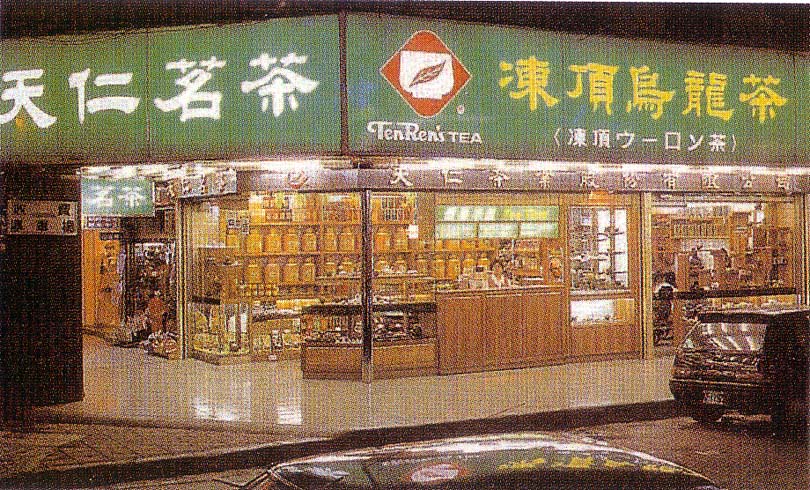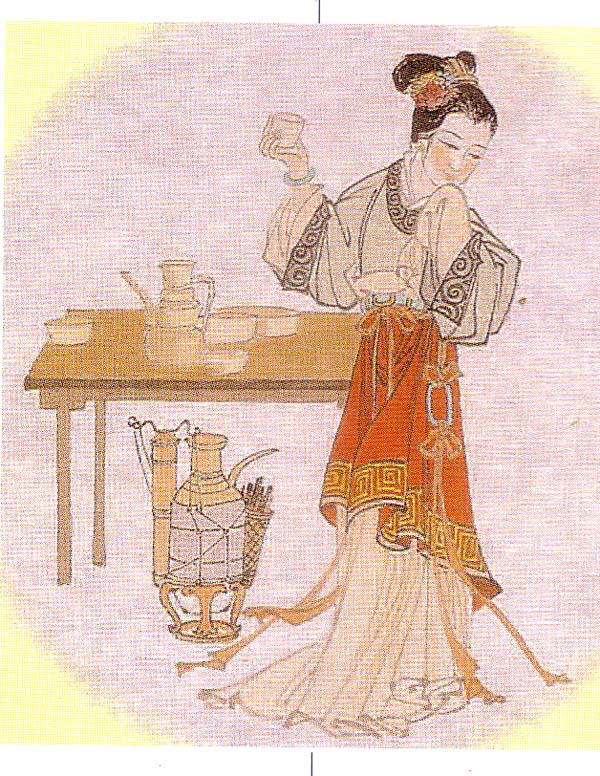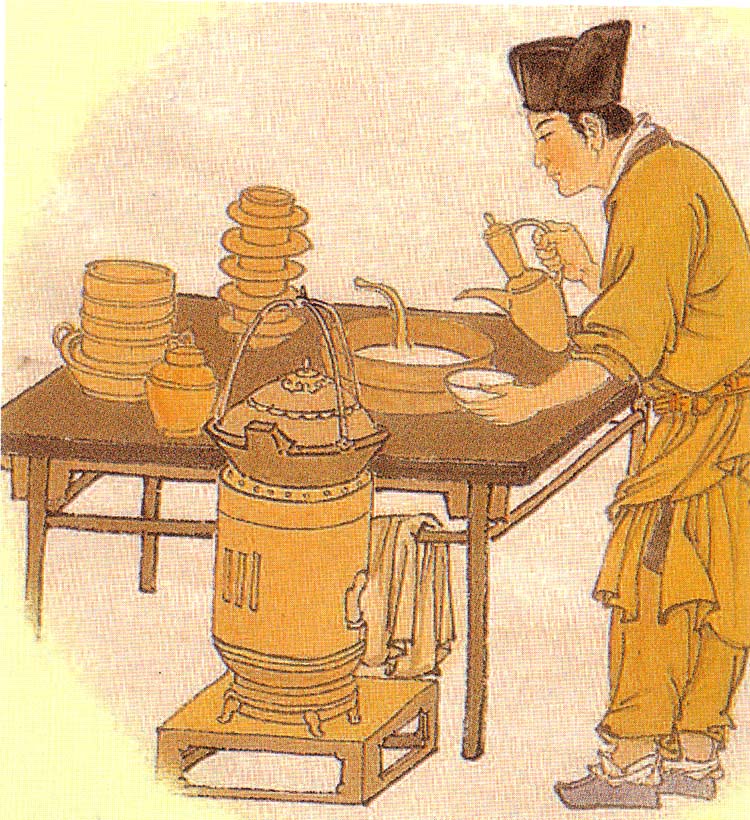
| What is Flavor and Fortune? |
| How do I subscribe? |
| How do I get past issues? |
| How do I advertise? |
| How do I contact the editor? |
Read 13021872 times
Connect me to:
| Home |
| Articles |
| Book reviews |
| Letters to the Editor |
| Newmans News and Notes |
| Recipes |
| Restaurant reviews |
| Article Index (all years, slow) |
| List of Article Years |
| Article Index (2025) |
| Article Index (last 2 years) |
| Things others say |
| Related Links |
| Log In... |
| Authors |
| Categories & Topics |
A Tea-riffic Story of Two 'Tens'
| by Jacqueline M. Newman |
Beverages
Summer Volume: 2007 Issue: 14(2) page(s): 32, 36, and 37
 Tea, the beverage from the plant Camellia sinensis, has been the national drink of China for years, how many is not a question that is easy to answer. Did Shen Nong, China's originator, drink it? Early stories of the leaves of this beverage falling into hot water abound. This magazine has written several articles about this wonderful beverage including ones in Volumes 2(4) on pages 9, 22, and 23; Volume 6(1) on pages 5, 6, 22, and 23; Volume 6(4) on pages 5 and 6; and Volume 13(3) on pages 12-14 and 35. There was even a tea test in Volume 4(4) on pages 10, 12, and 21.
Tea, the beverage from the plant Camellia sinensis, has been the national drink of China for years, how many is not a question that is easy to answer. Did Shen Nong, China's originator, drink it? Early stories of the leaves of this beverage falling into hot water abound. This magazine has written several articles about this wonderful beverage including ones in Volumes 2(4) on pages 9, 22, and 23; Volume 6(1) on pages 5, 6, 22, and 23; Volume 6(4) on pages 5 and 6; and Volume 13(3) on pages 12-14 and 35. There was even a tea test in Volume 4(4) on pages 10, 12, and 21.
The tales and folk who tout this beverage may heighten some folks love of it, be it its historical or enduring value. Tea was certainly not an important crop in China's early days. It was of minor importance years later and was of minimal importance to the Mongolian rulers in a later dynasty. However, times do change, and since their overthrow, there is no doubt this now-considered 'national drink of China' is important politically, economically, and personally to the Chinese. It is also of considerable importance to the English and to many others. This importance grew after the establishment of the Ming Dynasty in 1368 when the Mongolians were no longer in power.
One does not need to know the origins of this beverage to appreciate the pleasures it provides even if one does wonder how it became as popular as it is in China and elsewhere today. One needs not know much about who some of the leading proponents, producers, and purveyors were and still are to appreciate a good cup of tea. One may wonder how and who boasted even bagged tea in recent years; and if you are our age you might recognize the name of Arthur Godfrey who had a role in American's drinking a tea that is not at all Chinese. But the question remains, when thinking of Chinese tea, who at least in this era of huge companies may have founded the first tea company to be publically traded in Taiwan and in China.
This is an interesting story that began some fifty-five years ago in Taiwan. It has to do with Rie Ho Lee, whose name you may have seen as Lee Ray Ho. What this man began in his own small way is now hundreds of independent company-owned or company-controlled stores and additional outlets in department stores. He started making products that are now made in at least three tea manufacturing plants. He founded a foundation to educate about tea. He oversaw modern tea houses and places that promote Chinese tea art; and he even began places where one stops for gas and can get a decent cup of tea.
In 1953, Mr. Lee began his tea empire at the Ming Fong Tea shop in Kong-sun, Kaohsiung Hsien in Taiwan. Eight years later, and now called the Ten Ren Tea Co. Ltd., his company opened their first retail store in Tainan City, also in Taiwan. Then, in 1975, his company's name and his company's logo became a registered trademark. All this time, his tea planting, then its manufacture and distribution, developed its own unique style while remaining a small business.
That changed in 1978 when his company constructed the largest modern tea plant in the far east. Were that not enough, a year later his company imported the first tea bag producing machine. It came from Italy and was made by a company called Ima. People and politicians tasted and took note. In 1983, his company was given a prestigious award by the Taiwan Provincial Health Administration. In 1986, Rosa Food Industry Ltd. was authorized to manufacture and sell Ten Ren’s newest item, a ready-to-drink tea beverage. And on and on it goes, progress after progress, award after award. The increase in the benefits of tea, greater general public awareness, more varied products, and increases in sales followed. Mr. Lee's company was a leader in tea manufacture and tea marketing; it was ahead of its time.
In 1992, Ten Ren developed teahouses to market and promote bubbly black tea. In 1993, they imported their fifth automatic tea bag packaging machine. The following year they introduced green and other tea cakes, and other products. Now their three manufacturing plants and more than one hundred acres are dedicated to their teas; and they do so much more.
In many cities world-wide, there are Ten Ren tea places to taste and drink tea. They cooperate with the Lu Yu Tea Art Centre and they have a Ten Ren Tea Art Cultural Foundation. In addition, Ten Ren has established 'Tea Time.' These are modern tea houses where people can have cheerful places to enjoy tea. At them and their regular tea stores, one can purchase various minimally or more processed fresh tea leaves, and teas that are in season.
Ten Ren tea stores also sell tea utensils such as tea pots, tea strainers, tea cups and saucers, and of course many types of tea. In the United States there are many Ten Ren tea stores. In California, for example, they are in San Gabriel, Monterey Park, Los Angeles, and San Francisco. They are also in New York in several boroughs such as Manhattan and Flushing; they are in Chicago in Illinois, and they are elsewhere. Ourside of this country, we have visited Ten Ren stores in Yokahama and in Kobe Japan, in Penang in Malaysia, and elsewhere.
Why are Ten Ren and other tea companies important other than the fact that they are large Chinese food companies? For one, tea is consumed by more people world-wide than any other beverage, and it is on the tail of coffee which is America's most popular beverage. Companies have seen the popularity of the Ten Ren tea shops and they are imitating them. They know, and you do if you have visited any of them, that most tea shops sell more than just various kinds of hot tea. They sell tea in bottles and cans, in asceptic packaging, and in tea pots. They sell hot cups of tea and they sell glasses of iced tea. In Taiwan, China, and in Hong Kong there are tea shops that rival Starbucks; and they are growing in popularity.
Tea now has panache, and many say it has health giving properties. If you have visited a Ten Ren tea shop like the one illustrated on this page, you know they also sell a health-giving item, called ginseng. But that is a topic out of the realm of this article. This concentrates on a tea-rrific place in many places in the world to buy fine tea.

 Been to China and not seen a Ten Ren there? That could be because in 1993, Ten Ren's founder established another company called the Ten Fu Group. There are more than four hundred stores under that name and more than fifty franchises elsewhere. That is not all, Ten Fu in China started their first tea museum. It is in Zhangzhou, in the Fujian province. They created a second tea museum in Chengdu in the Sichuan province. These museums, display the history of tea and tea culture in China and in other countries. They have classrooms and performance areas to teach about and show tea ceremonies, and they have calligraphy and painting galleries and places to learn about these and other Chinese arts, of which tea drinking is one. The two pictures on these pages depict early tea drinking scenes.
Been to China and not seen a Ten Ren there? That could be because in 1993, Ten Ren's founder established another company called the Ten Fu Group. There are more than four hundred stores under that name and more than fifty franchises elsewhere. That is not all, Ten Fu in China started their first tea museum. It is in Zhangzhou, in the Fujian province. They created a second tea museum in Chengdu in the Sichuan province. These museums, display the history of tea and tea culture in China and in other countries. They have classrooms and performance areas to teach about and show tea ceremonies, and they have calligraphy and painting galleries and places to learn about these and other Chinese arts, of which tea drinking is one. The two pictures on these pages depict early tea drinking scenes.
Besides the museums and tea shops, the Ten Fu Group has five manufacturing plants in China, three in Fujian, and two in the Sichuan province; and like the Ten Ren folk, they work hard to educate folk about the history of tea and how to enjoy good teas. These two companies, Ten Ren and Ten Fu are similar but separate. Both have somewhat similar logos, and at every one of their stores, they offer each person entering, a complimentary cup of tea. Both maintain their traditional businesses and both have innovative products and do innovative things. What is tea-rrific, is that both sell an impressive array of different teas and various tea snacks and tea utensils. If you never visited a Ten Ren or Ten Fu store, look for their logo and stop in to enjoy a cup of their tea. Learn from them and other tea emporia that good tea really is tea-riffic.
Mark and Ellen Lii, at last count, now own and manage five Ten Ren Tea and Ginseng Company tea stores in the New York City region. They are in Manhattan, Queens, and Brooklyn. They invite you to come and try their tea. They also tell Flavor and Fortune, that they have a way for those who really can not get to their stores, to get their teas. Their answer is to go to www.tenrenusa.com and learn about where they are, what they have, and how anyone can purchase their teas. Should you have a burning tea question, Mark also says to e-mail him at mtealii@aol.com
Wonder how tea-rrific the business of selling and drinking tea really is? The Ten Ren Tea Co. and the Ten Fu Tea Co have a combined target of owning and/or operating one thousand retail locations. They are well on their way having reached more than half that goal. You can see them and sample their wares in many places, and we did just that some weeks back. We were flying home from San Francisco, had to change planes, and had to wait some hours in Chicago. There, at one of many fast food facilities in a very small out-of-the-mainstream terminal building, we spotted the words Ten Ren. Because we love tea and dislike most western tea bag tea, we were delighted to purchase and enjoy a cup of Ten Ren tea. There was no choice, they only sold Ten Ren's Green tea bag tea. We were delighted to have a great cup of tea in an airport.
On all occasions, which tea to buy is a personal decision. Should it be a pu-er tea. This magazine wrote about that type of tea in Flavor and Fortune’s Volume 10(1) on pages 23 and 24. Or should one drink a dark smoky woodsy Lapsang Souchong which is a tea we have yet to write about? Some prefer an oolong or partially oxidized tea such as a Tung Ting tea. This is, Taiwan’s most famous light fruity flowery tea said to have a long lasting taste. Perhaps try a Ti Kuan Yin tea that is also known as Iron Goddess of Mercy; it is from the Fujian province. Want to taste a Gunpowder tea from the Zhejiang province?
Maybe you saw Po Lo Chun tea touted, or Bilouchun spoken of. These tea words are for the same tea, just transliterated into the Roman alphabet differently. This variety of tea is said to be planted near apricot, peach, and/or plum trees and some believe these tea leaves absorb hints of these fruits. Can they, when these tea leaves are hand-picked and only in the spring?
What about a white teas; many like this light tea that some hardly know they are drinking tea. Is Jasmine tea your favorite? Good jasmine tea has flower petals layered over green tea leaves during the drying process. This allows the jasmine aroma and flavor to be absorbed.
All this new to you? Mr. Lee and Mr. Lii know that there is much to learn about Chinese tea. They, like many of you, have read that tea helps build immunity, helps reduce various diseases, fights the aging process, stimulates the nervous system, and more. They both say that learning about tea can be a tea-riffic health idea. They suggest you sample some good tea soon, and learn all you can about all aspects of tea. They are doing all they can to help everyone do just that.

Copyright © 1994-2025 by ISACC, all rights reserved
Address
3 Jefferson Ferry Drive
S. Setauket NY 11720